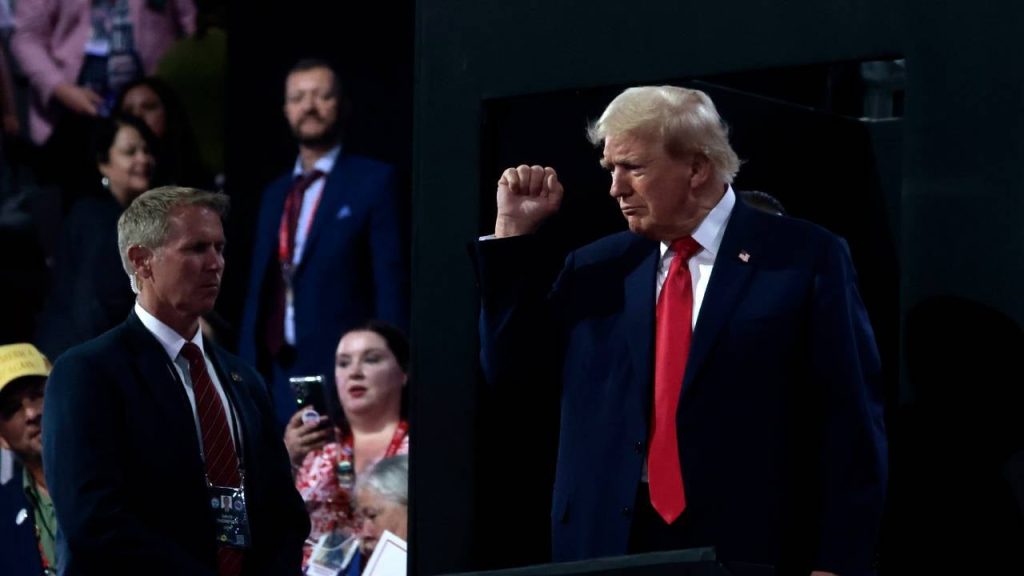Many investors have been enjoying a nice lift to their portfolios — from stocks to bonds to cryptocurrency — over the past week. In fact, the Dow Jones Industrial Average posted its best day since June 2023 on Tuesday and closed at an all-time high. Some analysts believe the recent rally is largely due to something called the “Trump Trade.”
While there’s no clear-cut definition of what the Trump Trade is, it seems to reflect a general sentiment among some investors that a second Donald Trump presidency could spell good news for the markets.
Deregulation, tax cuts and an increase in fiscal spending were all trademarks of the first Trump presidency. Investors banking on the Trump Trade expect these policies to make a comeback if he wins in November.
What is the Trump Trade?
The Trump Trade describes the shift in market behavior and investor actions in response to the economic policies and political moves associated with a potential Trump presidency. This concept was coined after his election in November 2016, as markets reacted to his pledges for deregulation, tax cuts and boosted infrastructure spending. Essentially, the Trump Trade reflects the expectation of a pro-business climate.
Back in Trump’s first term, U.S. stocks surged — especially in the tech and financial sectors — with rising Treasury yields and a strong dollar.
The stock market tends to be forward-looking, attempting to anticipate trends and disruptions well in advance. With less than four months until the presidential election, Trump is leading in many polls and some investors are already pricing in a victory. The recent presidential debate and an assassination attempt on Trump on July 13 have only fueled the anticipation.
Why investors are betting on the Trump Trade
To understand the growing popularity of the Trump Trade concept and what markets anticipate, it’s important to understand how the markets behaved during Trump’s previous presidency and what it could mean this time around.
The stock market
U.S. stocks — especially in tech, financials, industrials and energy — saw significant gains during Trump’s term. The Tax Cuts and Jobs Act of 2017, which reduced corporate tax rates, was a major win for tech companies, leading to increased investments, stock buybacks and dividends. The S&P 500 rose nearly 50 percent from Trump’s election until the beginning of the COVID-19 pandemic.
Stock markets usually respond more to earnings forecasts and economic fundamentals than to trending political news. Up to this point, the presidential race between Trump and President Joe Biden hasn’t significantly influenced the stock market.
Instead, the recent uptrend is largely fueled by robust corporate earnings, especially from companies within the S&P 500, which is enjoying its most substantial earnings growth in years.
However, one stock in particular saw a substantial rally after the assassination attempt: Trump Media. Shares of Trump Media and Technology Group (DJT), the parent company of the social media platform Truth Social, closed more than 30 percent higher on Monday, just two days after the attempted assassination.
Bond markets
Expectations of more government spending and a hawkish Federal Reserve led to rising Treasury yields after Trump’s election. The 10-year U.S. Treasury yield went from 1.82 percent in November 2016 to 3.23 percent in November 2018, then dropped as recession fears grew due to tightened monetary policies.
A potential Trump victory in 2024 could have significant impacts on the bond market. If Trump wins, some analysts believe it could mean that the Federal Reserve might hesitate to cut interest rates, given that potentially higher deficit spending might boost the U.S. economy and drive up inflation.
As a result, bond prices may decline while yields rise. Investors are closely watching for these potential shifts since they could reshape market dynamics and influence investment strategies.
A strong dollar
The U.S. dollar appreciated against other major currencies during Trump’s first term, driven by expectations of higher interest rates and stronger economic growth.
While the dollar was strong during most of his term — especially from January to March 2017 — it wasn’t “the strongest dollar in history,” as Trump frequently claimed and PolitiFact debunked.
A strong dollar can increase the cost of U.S. exports, making them less competitive, and potentially reduce the profits of American companies operating abroad when their earnings are converted back to dollars. Although a strong dollar can reduce the cost of imported goods, it may also drive up inflation and negatively impact foreign investments.
Bottom line
As the election approaches, investors must consider how much of the Trump Trade is already priced into the market. It’s also vital to proceed with caution, as markets tend to be historically volatile in the months leading up to a presidential election, generating big swings in either direction.
A long-term outlook, as well as a focus on fundamentals and corporate earnings, will serve investors well, regardless of the election outcome.
Editorial Disclaimer: All investors are advised to conduct their own independent research into investment strategies before making an investment decision. In addition, investors are advised that past investment product performance is no guarantee of future price appreciation.
Read the full article here










